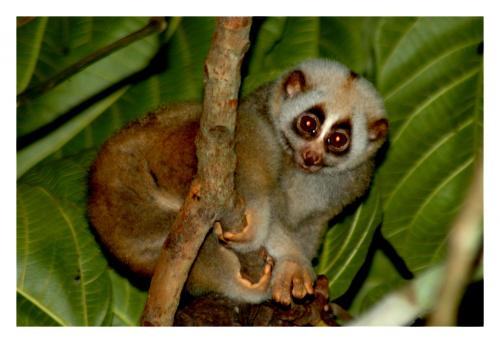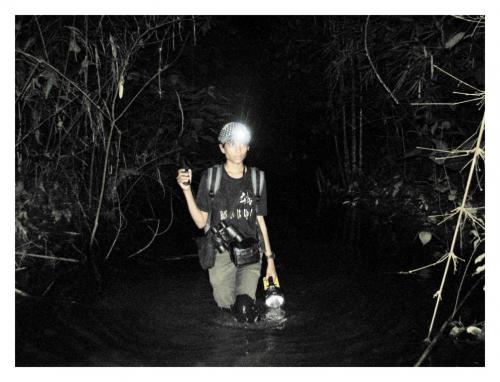Enigmatic primates in exotic locations revealed by NCBS researcher
A torch beam flashes and there is a glimpse of fur between the branches. A loris goes about its nightly business of feeding by trying to catch insects with its hands or gouge out resins from tree-holes, extricating itself from a mess of climbers and being bitten by mosquitoes. The Bengal slow loris is one of the three species of a genus of nocturnal primate found only in South Asia. They live in the rainforests of North-East India, sharing their habitats with a host of other interesting creatures such as leopard cats, civets, muntjacs, snakes, birds and spectacularly coloured moths. But beyond the rosy picture, the slow loris is threatened by the extremely lucrative illegal wildlife trade. Recent studies and market surveys have shown that slow lorises are one among the most commonly seen primate species in markets across their range. This has resulted in shifting the species from Appendix II to Appendix I of the CITES in 2007. Sadly, not enough is known about this widespread species (northeast India, Burma, Cambodia, southern China, Laos, Thailand and Vietnam) to put in place effective conservation measures.
One of the first studies on the distribution and behaviour of the Bengal slow loris, was conducted by Swapna N from the Master’s program in Wildlife Biology and Conservation, National Centre for Biological Sciences. Swapna, who recently presented her Master’s dissertation work at the International Primatology Conference in Kyoto, Japan, says, “Prior to my study on the feeding ecology of the Bengal slow loris, only two ecological studies had been carried out - one on the greater slow loris and the other on the pygmy slow loris. Apart from these, the only information was from a few rapid surveys which provided information on the occurrence of this species through reports of opportunistic sightings, and the bulk of the information came from studies in captivity”. Between 12th and 18th September, 2010, she presented her work amongst over 1000 peers, both eminent and emerging primatologists. Through a workshop on coexistence of human and non-human primates she and 14 others shared the challenges they faced and learnt strategies to conserve primates in human-dominated landscapes. During the conference she realized that hers was one of the very few studies on nocturnal primates. This has strengthened her resolve to continue studying lorises particularly the Bengal loris in India.
Following her research, Swapna joined the Tripura JICA (Japan International Co-operation Agency) project. A small but important component of this project was biodiversity conservation and she managed the inventory work of plants, mammals, birds, butterflies & fish to assess dependence of people on biological resources. Along with a team of novice but enthusiastic local youth and forest department personnel, she collected baseline information on mammals from selected remote forested areas through reconnaissance surveys (day and night) and also by interviewing local people. Beyond the wonderful wildlife, she was exposed to the harsh ground realities of human pressure on forests by observing forest clearance for fields and plantations (2nd highest rubber producing state after Kerala) firewood, bamboo and NTFP collection, intentional and accidental fires, constant movement of people and livestock through forests. “The once greater than 60% forest cover has been dramatically reduced with a considerable number of poor forest dependent communities. Apart from economic and subsistence values seldom are other values or importance attached to wild resources”, says Swapna. The lack of trained, dedicated forest staff and interest by wildlife biologists could also be a cause for the current state of affairs.
She feels that she owes her interest and accomplishments to Dr Mewa Singh, Dr Ajith Kumar, Dr Anindhya Sinha, Dr Sindhu Radhakrishna, Dr Anna Nekaris, Dr Kaberi Kar Gupta and Dr Atul K Gupta. The fascination she holds for nocturnal primates like the loris has inspired her to specialize in further research into their ecology and behaviour.


Comments
Post new comment